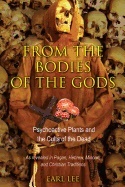
From the bodies of the gods - psychoactive plants and the cults of the dead
Long before the beginnings of civilisation, humans have been sacrificed and their flesh used to produce sacred foods and oils for use in religious rites. Originating with the sacred harvest of hallucinogenic mushrooms from the corpses of shamans and other holy men, these acts of ritual cannibalism and visionary intoxication are part of the history of all cultures, including Judeo-Christian ones and provided a way to commune with the dead. These practices continued openly into the Dark Ages, when they were suppressed and adapted into the worship of saintly bones - or continued in secret by a few “heretical” sects, such as the Cathars and the Knights Templar. While little known today, these rites remain deeply embedded in the symbolism, theology and sacraments of modern religion and bring a much more literal meaning to the church's “Holy Communion” or symbolic consumption of the body and blood of Christ. Documenting the sacrificial, cannibalistic and psychoactive sacramental practices associated with the Cult of the Dead from the prehistoric Minoans on Crete to the ancient Egyptians and Hebrews and onward to early and mediaeval Christian sects, Earl Lee shows how these religious rites influenced the development of Western religion. In particular, he reveals how Christianity originated with Jesus's effort to restore the sacred rites of Moses, including the Marzeah or Feast for the Dead. Examining the connections between these rites and the mysterious funeral of Father Sauniere in Rennes-le-Château, the author explains why the prehistoric Cult of the Dead has held such power over Western civilisation, so much so that its echoes are still heard today in our literature, film and arts. . Explores ancient practices of producing sacred hallucinogenic foods and oils from the bodies of the dead for ritual consumption and religious anointing . Explains how these practices are deeply embedded in the symbolism, theology and sacraments of modern religion, specifically Christianity and the Eucharist . Documents the rites of Cults of the Dead from the prehistoric Minoans on Crete to the ancient Egyptians, Greeks and Hebrews to early and mediaeval Christian sects such as the Cathars
Utgiven: 2012
ISBN: 9781594774584
Förlag: Park Street Press
Format: Häftad
Språk: Engelska
Sidor: 256 st
Long before the beginnings of civilisation, humans have been sacrificed and their flesh used to produce sacred foods and oils for use in religious rites. Originating with the sacred harvest of hallucinogenic mushrooms from the corpses of shamans and other holy men, these acts of ritual cannibalism and visionary intoxication are part of the history of all cultures, including Judeo-Christian ones and provided a way to commune with the dead. These practices continued openly into the Dark Ages, when they were suppressed and adapted into the worship of saintly bones - or continued in secret by a few “heretical” sects, such as the Cathars and the Knights Templar. While little known today, these rites remain deeply embedded in the symbolism, theology and sacraments of modern religion and bring a much more literal meaning to the church's “Holy Communion” or symbolic consumption of the body and blood of Christ. Documenting the sacrificial, cannibalistic and psychoactive sacramental practices associated with the Cult of the Dead from the prehistoric Minoans on Crete to the ancient Egyptians and Hebrews and onward to early and mediaeval Christian sects, Earl Lee shows how these religious rites influenced the development of Western religion. In particular, he reveals how Christianity originated with Jesus's effort to restore the sacred rites of Moses, including the Marzeah or Feast for the Dead. Examining the connections between these rites and the mysterious funeral of Father Sauniere in Rennes-le-Château, the author explains why the prehistoric Cult of the Dead has held such power over Western civilisation, so much so that its echoes are still heard today in our literature, film and arts. . Explores ancient practices of producing sacred hallucinogenic foods and oils from the bodies of the dead for ritual consumption and religious anointing . Explains how these practices are deeply embedded in the symbolism, theology and sacraments of modern religion, specifically Christianity and the Eucharist . Documents the rites of Cults of the Dead from the prehistoric Minoans on Crete to the ancient Egyptians, Greeks and Hebrews to early and mediaeval Christian sects such as the Cathars
Begagnad bok (0 st)
Varje vecka tillkommer tusentals nya säljare. Bevaka boken så får du meddelande när den finns tillgänglig igen.



